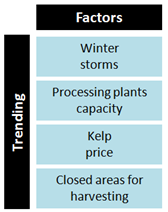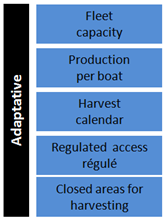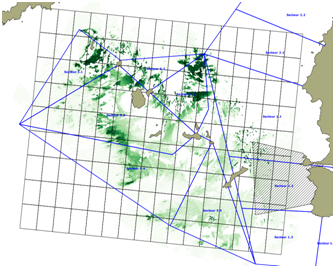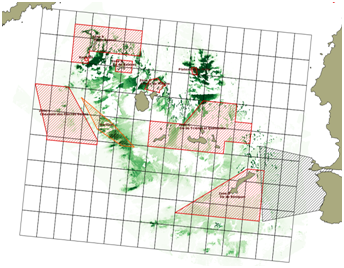5.5.8 Parc Naturel Marin d'Iroise: Detailed description of the scenarios approach

The scenario approach developed in the Parc Naturel Marin d'Iroise was based on the modelling tool’s ability to simulate the influence of adaptive strategies on ecosystem services which itself arises from an integrated approach started several years ago.
Thus, we can identify steps initiated to the VALMER project process (A), and steps mainly developed during the project (B):
- A.1. Mapping of the rocky cover of the Molène archipelago.
- A.2. Data acquisition on the kelp population throughout the Molène’s archipelago in order to feed a statistical model of the kelp biomass spatial distribution.
- A.3. Monitoring of fishing effort and harvested kelp using equipment deployed by volunteer fishing vessels and managed by Ifremer.
- A.4. Identification by stakeholders of areas with high environmental value (rest area, breeding, nursery, presence of species or habitat of European interest) where fishing could be banned.
- B.1. Refinement of the scope of the ES assessment during the Triage process following the identification of change within the social-ecosystem
- B.2. Gathering of the available data on marine activities related to the kelp habitat in the Parc Naturel Marin d'Iroise
- B.3. Determination of management measures for kelp fisheries on a finer scale than exist currently within the designated areas
- B.4. Comparison of scenarios with different management options, through a multi-criteria analysis grid
The basic structure of the management options was produced by the collaborative management system between harvesters, managers and state representatives. Additional expertise was required to further define operational rules or other factors of change regarding environmental drivers (climate), ecological status or economic constraints and opportunities.
This additional information for defining scenarios was gathered through interviews or focus-group meetings of scientists, Parc Naturel Marin d'Iroise officers, fishermen and kelp processing plants representatives. The scenario process followed the 5 following steps.
Step1
A scenario planning meeting was organized in June 2014 with scientists and managers with the objective of analysing the system drivers previously indentified. The Triage process ![]() helped the team to focus on the more relevant factors of change and the discussion of the influence of local management on ecosystem services in comparison with global pressures. This step was important for the integration of the appropriate levers in the dynamic system model. Factors of change were divided into two categories: exogenous factors that describe possible future evolutions and internal factors that reflect the ability of the system to develop adaptive strategies. Both categories are described as following:
helped the team to focus on the more relevant factors of change and the discussion of the influence of local management on ecosystem services in comparison with global pressures. This step was important for the integration of the appropriate levers in the dynamic system model. Factors of change were divided into two categories: exogenous factors that describe possible future evolutions and internal factors that reflect the ability of the system to develop adaptive strategies. Both categories are described as following:
TRENDING FACTORS OF CHANGE

 Environmental factors:
Environmental factors:
Winter storms events remove large amounts of kelp plants and modify the spatial distribution of algae fields. The increase in the number and the strength of winter storm events had been documented but is recognized as being an uncontrollable external factor.
 Economic factors:
Economic factors:
The market for alginates is worldwide. Thus the Iroise kelp production depends on global trades rules. The kelp demand is increasing and kelp prices (different from a specie to another) are subject to fluctuations. In order to meet this demand, the kelp processing plants are increasing their treatment capacity.
 Regulatory factors:
Regulatory factors:
Creation of marine protected areas and set up of closed areas for exploitation.
ADAPTATIVE FACTORS OF CHANGE

 Economic factors:
Economic factors:
Fishermen have individual contracts with two local kelp processing companies. These private contracts and the plant’s alginate extraction capacity drive the harvest effort on a daily basis. These contractual bounds influence the fleet composition and capacity. The fleet targeting the both species is composed of eight boats. Seven boats with a hold capacity lower than thirty tonnes harvest L. digitata only.
A shift in fleet capacity between L. hyperborea and L. digitata may occur. Changes within the fleet towards larger L. hyperborea mono-specific designed boats were tested.
The strategy of the processing industry may also result in a relocation of the fishing fleet activities toward less controlled areas outside the park, with possible positive effects on all ecosystem services in the park perimeter, except the food provisioning ones.
 Regulation factors:
Regulation factors:
Licenses
Most of the kelp production comes from L. digitata, which is supplied, to the agrifood industry. Nonetheless, the increasing demand for harvesting L. hyperborea, driven by the pharmaceutical industry, raises an important policy issue. L. hyperborea is currently targeted by vessels exploiting both species. In response to the needs of the pharmaceutical industry, some vessels, which are currently harvesting L. digitata only, could also ask for a fishing licence for L. hyperborea. The fishing effort could significantly increase despite a stable number of boats.
Quotas
The set-up of individual quotas is another regulation perspective.
Harvest calendar

The fleet specialized for L. hyperborea harvesting is also equipped for L. digitata. Usually the kelp harvesters change the device used, from the comb to the scoubidou at the end of March. The L. hyperborea harvest starts again in October. The scoubidou’s use is not forbidden during spring and summer because L. digitata is targeted at this productive period of the year. Under the increasing demand of L. hyperborea, the fleet could become mono-specific and change its harvest calendar. In order to preserve the ecological functions of the kelp field during the productive period, an option tested is the banning of the comb use from June to October.
Regulated access The maritime area is subdivided into large zones and sectors, with a fallow period of five years when the quota of the fishery is reached (delimited in blue on the figure opposite). The state representative regulation of 2014 asks to the professionals to organize the access to the resource on a more refined regular grid for the 1st January 2015.
The maritime area is subdivided into large zones and sectors, with a fallow period of five years when the quota of the fishery is reached (delimited in blue on the figure opposite). The state representative regulation of 2014 asks to the professionals to organize the access to the resource on a more refined regular grid for the 1st January 2015.
Many options of rotation period were tested: three and seven years, in order to assess the time required for the ecological functions restoration.
Many proposals were tested on the grid of 1’x1’ resolution. The quotas were also discussed in the scenario exercise.
Closed areas  Aiming to (1) answer to the global trend conservation areas creations for the protection of the marine resources and (2) control the exploitation system, the local stakeholders of the Parc Naturel Marin d'Iroise debated these last months of management interventions. They defined closed areas with different purposes (biodiversity reservoir, refuge area for marine mammals, co-location with other fishermen and reference zone for scientific survey) and seasonal rules for kelp harvesting. They became effective in May 2014 by a state representative regulation (n° 2014-9271 decree).
Aiming to (1) answer to the global trend conservation areas creations for the protection of the marine resources and (2) control the exploitation system, the local stakeholders of the Parc Naturel Marin d'Iroise debated these last months of management interventions. They defined closed areas with different purposes (biodiversity reservoir, refuge area for marine mammals, co-location with other fishermen and reference zone for scientific survey) and seasonal rules for kelp harvesting. They became effective in May 2014 by a state representative regulation (n° 2014-9271 decree).
Step 2
The actors of the kelp sector also asked for a better understanding of how the spatial allocation of the fishing effort was estimated from the revenues and costs under constraints optimization in the bio-economic model.
In October 2014, the scenario approach was presented to the kelp harvesting sector during a meeting of the kelp-working group of the Regional Fisheries Committee (CRPMEM). This working group was commissioned by the 2014-9271 decree to define new access rules (quotas, rotation sectors, harvesting calendar and fallow period). The VALMER team put forward the benefits of the new insights provided by the Ecosystem Services Approach. Many preliminary results of the Ecosystem Services Assessment state of reference had been shown. The presentation of the VALMER project also aimed to involve these stakeholders in the scenario building, in order to redefine the description of the fishery adaptive strategies. The model needed to be as realistic as possible to be accepted by this community.
Step 3
The involvement of stakeholder was successful, especially for developing the participative approach, with a group of five or six people who had also agreed to participate to one future meeting that was to occur in November 2014.
Step 4
The scenarios description was refined in January and February 2015. The VALMER study site team presented the factors of change to the kelp sector interests during a meeting of the Regional Fisheries Committee (CRPMEM) kelp commission in January.
The next step of the scenario building exercise would have been to organize a workshop with a larger range of stakeholders. The team prepared this workshop and developed methodologies (Régnier abacus, deliberation matrix). But at the last moment, the team was confronted with misunderstandings from some stakeholders.
In such a short time, at the end of the VALMER exercise, the time was not favourable to organising a meeting of a various range of stakeholders. It was decided to not formalize scenarios with them but only to demonstrate the usefulness of the model with theoretical scenarios proposed by the case study team.
What were the advantages and disadvantages of the scenarios methods used?
When a participative approach is developed for the scenario building exercise in a well-established institutional framework, it requires the involvement of pre-identified stake-holders.
The scenario approach was completely dependent of the construction, in parallel, of the dynamic model of the kelp social-ecosystem, which was also based on a participative approach. These two methodologies fed each other. At the end of the exercise, one integrated tool was available for the ecosystem services assessment with a multi-criteria grid for the analysis. When finished, this tool is particularly operational for helping the decision-making process. The risk is to under-estimate the time required by these two steps, in particular to achieve stakeholder involvement. In this context, stakeholder involvement tries to find a balance between a sufficient level of participation to the building of both the model and the scenarios, while avoiding too much additional work for the participants.

